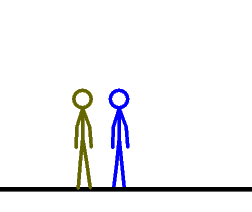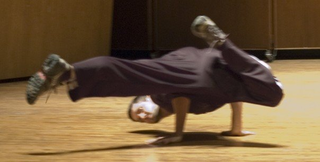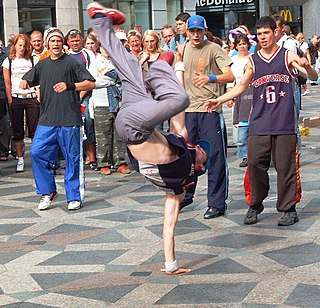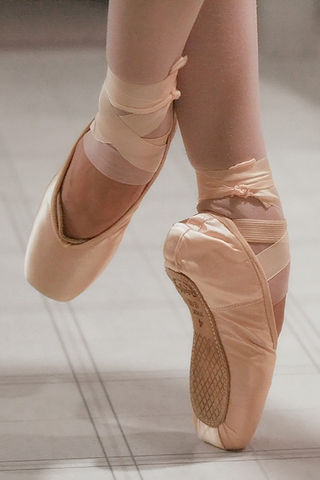This is a list of dance terms that are not names of dances or types of dances. See List of dances and List of dance style categories for those.
Professional wrestling throws are the application of professional wrestling techniques that involve lifting the opponent up and throwing or slamming them down. They are sometimes also called "power" maneuvers, as they are meant to emphasize a wrestler's strength. Many of these moves are used as finishers by various wrestlers, who refer to them by several different names that reflect their gimmick. Moves are listed under general categories whenever possible.
Professional wrestling holds include a number of set moves and pins used by performers to immobilize their opponents or lead to a submission. This article covers the various pins, stretches and transition holds used in the ring. Some wrestlers use these holds as their finishing maneuvers, often nicknaming them to reflect their character or persona. Moves are listed under general categories whenever possible.
Strikes can be offensive moves in professional wrestling, that can sometimes be used to set up an opponent for a hold or for a throw. There are a wide variety of strikes in pro wrestling, and many are known by several different names. Professional wrestlers frequently give their finishers new names. Occasionally, these names become popular and are used regardless of the wrestler performing the technique.

A powerbomb is a professional wrestling throw in which an opponent is lifted and then slammed back-first down to the mat. The standard powerbomb sees an opponent first placed in a standing headscissors position. The opponent is then lifted on the wrestler's shoulders and slammed down back-first to the mat. A prawn hold is commonly used for a pinning powerbomb.

Backbreaker refers to a kind of professional wrestling move which sees a wrestler dropping an opponent so that the opponent's back impacts or is bent backwards against a part of the wrestler's body, usually the knee. The standard version of the move sees the wrestler scoop their opponent horizontally before dropping to one knee, slamming the opponent's back on their other knee.
In professional wrestling, a neckbreaker is any throw or slam that focuses its attack on the opponent's neck. One type of neckbreaker involves the wrestler slamming an opponent's neck against a part of the wrestler's body, usually the knee, head or shoulder. The other type of neckbreaker is a slam technique in which the wrestler throws an opponent to the ground by twisting the opponent's neck. This also refers to a "back head slam" where a wrestler drops to the mat while holding an opponent by their neck.

Breakdancing or breaking, also called b-boying or b-girling (women), is a style of street dance originated by African Americans and Puerto Ricans in the Bronx.

The Windmill is a popular breakdancing move. The breaker rolls their torso continuously in a circular path on the floor, across the upper chest/shoulders/back, while twirling their legs in a V-shape through the air.

The flare is an acrobatic move in which the performer alternates balancing the torso between either arm while swinging the legs beneath in continuous circles. It is a fundamental b-boying/bgirl power move, and in gymnastics it may be performed on a pommel horse or during the floor exercise. The move is commonly spelled flair in gymnastics and further may be called a "Thomas flair" after its originator, Kurt Thomas.
Drops are breakdancing techniques that allow b-boys to transition down to the floor and begin performing downrock. Drops may be designed to look flashy, painful, or both. A wide variety of other movements can serve the same purpose, and others such as the kip-up can work in reverse, moving the breaker up from the floor.

The float or turtle is a b-boying move in which breakdancers turn on their hands with their body horizontal to the floor. Its origins are from basic gymnastics.

A freeze is a b-boying technique that involves halting all body motion, often in an interesting or balance-intensive pose, for a few seconds. It is implied that the position is hit and held from motion as if freezing in motion, or into ice. Freezes often incorporate various twists and distortions of the body into stylish and often difficult positions.
Locking is a style of funk dance. The name is based on the concept of locking movements, which means freezing from a fast movement and "locking" in a certain position, holding that position for a short while and then continuing at the same speed as before. It relies on fast and distinct arm and hand movements combined with more relaxed hips and legs. The movements are generally large and exaggerated, and often very rhythmic and tightly synced with the music. Locking is performance oriented, often interacting with the audience by smiling or giving them a high five, and some moves are quite comical.

Tiptoe describes the human body posture and locomotion of removing the heel(s) of one or both feet from the ground. The term is mostly used colloquially when the weight is placed on the balls of the feet rather than literally on the tips of the toes; literal tip-toeing is difficult but possible, as in the pointe technique of ballet. In running, landing on the ball of the foot is known as forefoot strike.

An acrobatic flip is a sequence of body movements in which a person leaps into the air and rotates one or more times while airborne. Acrobatic flips are commonly performed in acro dance, free running, gymnastics, cheerleading, high jumping, tricking, goal celebrations, and various other activities. This contrasts with freestyle BMX flips, where a person rotates in the air along with a bicycle.
Poi tricks are defined by the manipulation and combination of several variables of the spinning activity. These variables typically include, but are not limited to, the following:









